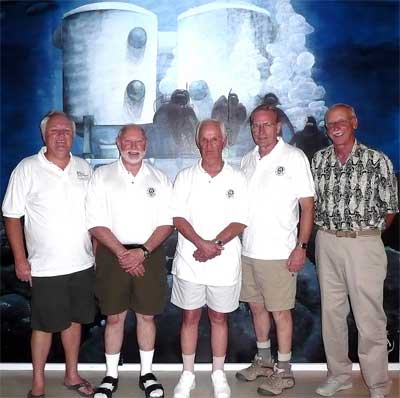Tektite’s 40th Anniversary Fete
Tektite Museum at VIERS are (l to r) Randy Brown,
Ed Clifton, Jim Miller, Conrad Mahnken, and
Bruce Schoonover
(A presentation by board member Bruce Schoonover, summarized by Robin Swank)
A large enthusiastic audience gathered at the Virgin Islands Environmental Research Station (VIERS) on February 15, 2009 to commemorate the 40th anniversary of the ‘splash down’ (beginning) of Tektite I. Three engaging (and in really good shape!) Tektite veterans— Jim Miller, the Tektite I Deputy Project Manager, and returning Aquanauts Conrad Mahnken and Ed Clifton— were on hand to answer questions and recall some tense and some humorous events during the Tektite project. We were royally hosted by Randy Brown of Clean Islands International and the VIERS staff, at the site where Tektite’s base camp was established more than four decades ago. St John Historical Board member Bruce Schoonover gave an absorbing presentation of Tektite’s emergence and its importance.
From the Project’s Tektite Tentacle to the SundayScape of Vacaville, California’s local paper, to Don Near’s article “Remembering Tektite” in the VI National Park’s Newspaper, this ‘local’ sensation was covered widely across the U.S. Its significance may not have been appreciated by political Washington at the time, but it was an absorbing life event for the thousands of U.S. citizens who contributed to its success. It was especially life–changing for the Aquanauts and contributing experts and academics on–site at Lameshur in the late 1960’s and early 70’s. And its science had broad implications for the future of diving as well as for living and working in space.
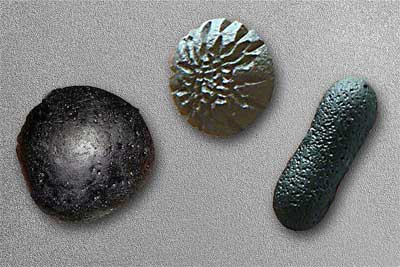
Tektites are a kind of meteoric brownish ‘glass’
which comes in many shapes, formed by their
re–entry into earths‘s atmosphere. There are
two on display at the Tektite Museum at VIERS.
Tektite was probably an obscure word at the time. But this mission to link oceanic and space exploration was aptly named after the space–borne matter that falls into the sea.
Bruce introduced his Tektite presentation with six minutes of photos, taken by Gary Davis, a Tektite I Alt. Aquanaut, and Charles Birkeland, a Tektite II Aquanaut. It was a good introduction to the ‘scientists–in–the–sea’ program. We saw images of both earthmen’s creation of their artificial underwater habitat, alongside sea creatures going about their business in the relatively undisturbed underwater terrain of sea grass beds, coral reefs, and sandy plains that became man’s world of study.
Why was Tektite launched? “Tektite was a product of the Space Race and the Cold War,” Bruce said. Russia’s Sputnik was successfully launched October 1957, and it shocked America that we could be at risk to a hostile country that now had ballistic missile launch capability.
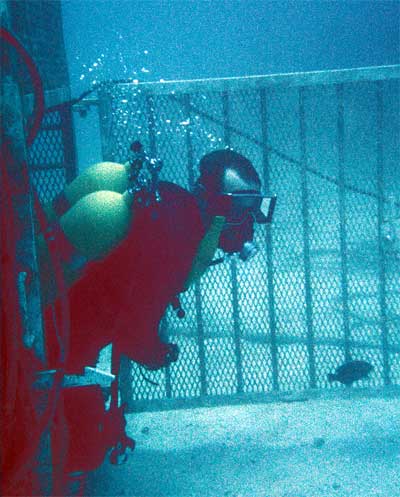
Aquanaut Ed Clifton shown
leaving the living quarters–the
Habitat–located 49 feet below
the surface of Lameshur Bay.
This realization brought industry, education, and the government together. In November of 1966 NASA and the Office of Naval Research met to discuss the similarities between space travel and undersea isolation. Living in a confined place in comradeship, while conducting productive scientific research needed study; beneath the sea seemed to be the place. Grumman, Inc. and GE’s Missile and Space Division proposed an undersea dwelling to simulate the isolation and confinement of living in space, but GE’s proposal was more consistent with NASA’s objectives. Ultimately, the U.S. Navy (the lead agency), NASA and the Department of the Interior jointly proposed a program which would include a 50 ft. underwater living and working structure, with a mission to last 60 days to mimic a contemplated orbiting Skylab mission duration.
Schoonover pointed out that for thousands of years man’s efforts to explore and exploit the oceans of the world had largely been hindered by an inability to remain submerged for long periods of time without getting, at best, ‘rapture of the deep,’ or at worst getting the ‘bends’ and dying. The 1960s saw great strides forward in this area. The Tektite program provided not only the arena for figuring out whether people could live confined in close proximity for 60 days without committing mayhem on each other, but also a venue for researching saturation diving limits and decompression requirements.
When one descends to the depths of the ocean, pressure increases and the nitrogen contained in the breathing mixture begins to be absorbed by the body’s tissues. Once a threshold time and depth is reached, one must go through decompression—the gradual reduction of pressure, that allows the nitrogen to be passed through the blood stream and from there to the lungs where it is exhaled. A failure to observe this requirement is what results in decompression sickness or the “bends.”
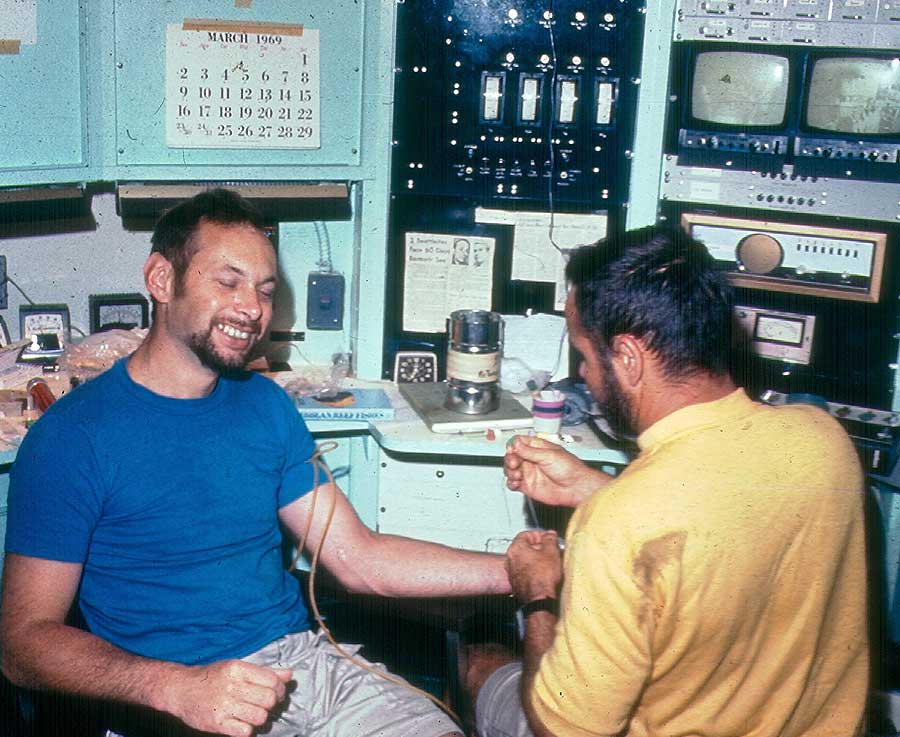
Crew Chief Rick Waller drawing blood
from Ed Clifton. The Aquanauts‘ health
was continually monitored during the 60
day mission.
However, in the 1950’s experiments had begun which theorized that if one stayed submerged for an extended period his tissues would ultimately reach their capacity in terms of nitrogen absorption (a condition known as saturation– thus the term ‘saturation diving’), in which case the amount of time required for decompression would no longer increase. The significance of this was that if true, for the first time in the history of man, it would permit extended stays underwater, thus increasing man’s ability to work and study the undersea environment.
Preceding the Tektite program were other projects that were conducting saturation diving research, among them Edwin Links’ ‘Man in the Sea’ , Jacque Cousteau’s ‘Conshelf’ and the US Navy’s ‘Sealab’ program. However, Tektite’s effort had three unique goals. One was to increase safe submersion time significantly… doubling the previously set record of 30 days. The second was to calibrate the use of nitrogen rather than helium (which was commonly used but more expensive and more difficult to obtain) as part of the breathing mixture. The third was to test man’s ability to conduct bona fide scientific research under these conditions, rather than to collect physiological or biomedical data on professional divers. Scientists were selected primarily on the basis of their research proposals and only secondly on their health and diving skills.
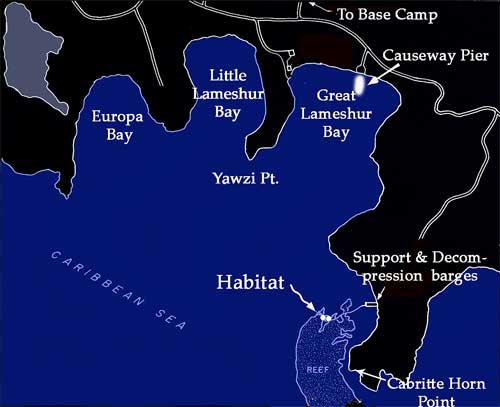
The Causeway Pier, Base Camp, Support Barge,
Decompression Barge and Tektite Habitat were
the five essential building blocks of the project.
Rick Waller was selected Crew Chief. He took a 60 day hiatus from his 3 pack a day cigarette habit to breathe 92% Nitrogen while conducting fisheries research. Ed Clifton was to study marine geology; Conrad Mahnken was to study ecology, plankton, and cleaner shrimp; and John van Derwalker, a fisheries biologist was to study, among other things, the life cycle of lobster. R.L. Phillips from the US Geological Survey, Gary Davis from the National Park, and Ian Koblich from the College of the Virgin Islands were chosen as alternates.
Great Lameshur was selected as Tektite’s site. Its isolation, the warm, clear, and protected waters, and its undisturbed marine diversity, which gave the scientists something to study, were ideal qualities. In addition, St. Johnian, Alvin White, who had been hired by GE, had called to Schoonover’s attention that its Missile and Space Division was very familiar with the VI. GE had conducted undersea weightless studies off Buck Island south of St. Thomas in the 1966–67 timeframe … as reported in a 1968 National Geographic article on the Virgin Islands. No doubt also weighing in on the choice of Great Lameshur Bay was the Interior Department’s familiarity with the Virgin Islands National Park waters as a result of the early and extensive marine research undertaken by Jack Randall under contract with the National Park Service.
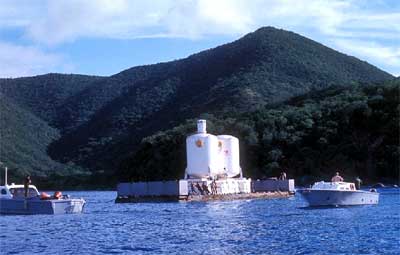
Habitat being readied to be submerged.
“Based on my reading of the boxes and boxes of internal documents and memos,” says Bruce, “the trials and tribulations encountered setting up the base camp and pier, acquiring and installing all the equipment, and making all the pieces come together in such a remote location could well have come directly out of the pages of Herman Wouk’s Don’t Stop the Carnival.”
First, a Causeway Pier was brought in by the U.S. Navy in three 90 ft. sections. Building materials could then be brought in and offloaded onto the pier. Base Camp was set up by an amphibious crew of the Seabees; it consisted of thirteen living units with generators, cook tent, sanitary systems and two 10,000 gallon fresh water tanks with pipes leading to the Pier. A Support Barge provided scuba gear charging units, the Habitat air supplier and monitoring equipment, the EEG equipment, and fresh water (‘always rubber–tasting and 80 degrees cold,’ noted the returning Aquanauts), It was moored about 400 ft. from the Habitat and was the communications link (data, visual, sound) between the Aquanauts and ‘Earth.’ The Decompression Barge housed and managed the raising and lowering of a Personnel Transfer Capsule (PTC) and linking it to the decompression chamber. The fifth element, the Habitat itself, was built by the GE Missile and Space Division in Valley Forge, Pennsylvania and then shipped from the Philadelphia Navy Yard. It was floated off its transport on airbags and then loaded with steel shot to help it submerge. Once it was winched to its rectangular base on the sea floor at 49 ft. below sea level in Beehive Cove, the pressure was set to 2.5 atmospheres and the breathing mixture set to 92% Nitrogen and 8% Oxygen. This is the equivalent of a 78% Nitrogen and 21% Oxygen environment at sea level.
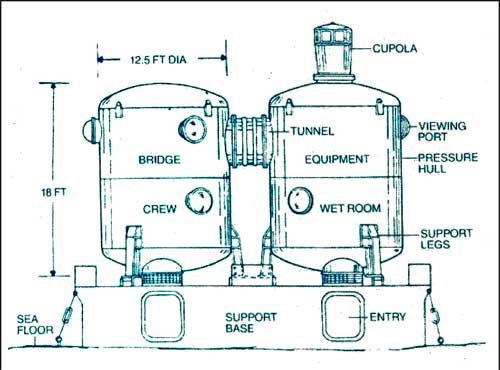
The Habitat—living and working quarters for
the aquanauts, 49 feet below the surface of
Beehive Cove in Great Lameshur Bay.
The two Habitat ‘silos,’ 18 ft. tall and 12 ½ ft. in diameter, were connected by a flexible tunnel. Inside this comfortable apartment/laboratory, large hemispherical portholes (there is one on display at the Museum) provided aesthetic and scientific visual entrée to the sea. The Wet Room was the Habitat entrance and its submerged stairway was always open to the sea; the wet lab, the scuba gear and a hot shower resided here. Above the Wet Room was the Equipment Room, essentially an engine room plus the toilets, and frozen food lockers. Also, food was lowered to them daily from above via Transfer Pots made out of commercial paint tanks. In the other silo, the lower level Living Quarters housed four bunks, an emergency exit, small galley (space–travel testing those GE appliances, of course!) a table/desk and storage lockers for personal gear, and a radio and a television set that received local channels. Above it, the Bridge housed the Control Center (with all the communications and personnel monitoring gear) and the Dry Lab. Umbilicals ran from the Support Barge to the Habitat, bringing fresh water, high pressure air for the scuba tanks, the Habitat’s breathing mixture and all the communications cables.
Talk about living in a fish bowl! Not only were the Aquanauts monitored for their physical health, but they were monitored at least 18 hours a day visually and by sound—to make sure there was no behavioral mayhem! Over 400,000 ‘observations’ were taken on their state of being during the 60 day submersion.
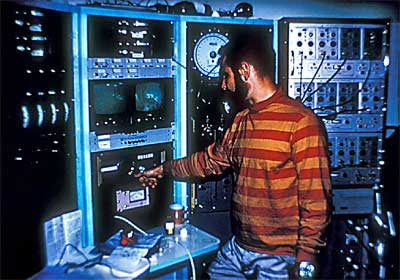
Control and monitoring panels were
located in the Bridge of Habitat.
In addition to the five major components of Tektite’s structure, there were five 2–person ‘way stations,’ bubble–domed cages with phones and extra scuba tanks, placed as refuges (from the sharks which, thankfully, never materialized) and as geographical outposts for use during scientific excursions. During the submersion period, Aquanauts spent about 7.2 hours per day outside the Habitat in marine research.
On April 15, 1969 the Personnel Transfer Capsule (PTC) descended to pick up the four Aquanauts. Although they volunteered to stay down longer (the food was excellent!), their handlers were firm. They entered the decompression chamber for 19 hours and 22 minutes, returning their blood Oxygen/Nitrogen to safe levels prior to being reunited with their families and then entering a 2 day debriefing period. The team set a world record for time underwater, previously held by Scott Carpenter in SeaLab II. Were there lingering after–effects? None, concluded Dr Edward Beckman. Other than a few ear problems, all men resurfaced mentally and physically healthy. And importantly, they proved valid the most obvious advantages of saturation diving from the Habitat—a huge increase in the time available for productive research and the research advantages of 24 hour observation.
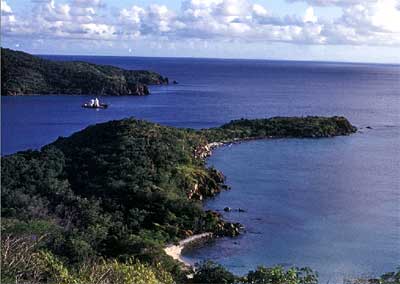
Unfortunately you can no longer see the under–
water Habit at its Great Lameshur Bay Site, even
with a case of nitrogen narcosis, or “rapture of
the deep.” The Habitat was sent back to
Pennsylvania where it sat idle of a number of
years. It was then sent to San Francisco and
used for educational purposes for a time, but
ultimately was cut up and sold as scrap.
Tektite II followed. Coordinated by the Department of the Interior, it was quite different in structure from the U.S. Navy’s Tektite program. There were 11 separate missions of from 13–20 days duration involving 53 scientists. A fifth Aquanaut, an engineer, was added to each team to manage the equipment. And an additional 7 missions were to be dedicated to 100 ft deep ‘explores’ in a new structure known as the “Minitat,” in order to estimate man’s aquatic competence and Nitrogen saturation tolerance at continental shelf depth. Eleven government agencies, 40 academic institutions, and 15 additional groups jumped aboard for Tektite II, providing projects and nominating Aquanauts for missions. All in all, about 500 off–island and warmly welcomed St. John residents chose to belong to Tektite II.
One disappointment was the Minitat—Teams spent five months trying to properly deploy the top–heavy Minitat; and once it broke loose in a tropical storm and was retrieved by a BVI fisherman and taken to Roadtown Harbor, Tortola—causing some embarrassment and the need to negotiate its release. Eventually they had to scrub its missions.
There were many successes. By the end of Tektite II all Diver Decompression tables were recalibrated, increasing the amount of Oxygen and the decompression time advised for safe diving. Rebreather units proved their worth. Invented by C.J. Lambertsen in 1942, the redeveloped GE Mark 10 rebreathers proved invaluable to biologists attempting to observe seafloor life unobtrusively. With their internal Baralyme air ‘scrubber,’ they enabled divers to stay submerged for 12 hours without noisy bubbles and the up and down movement caused by inhaling and exhaling. Forty–eight divers used the Rebreathers on tasks for 1–6 hours in length, producing more accurate behavioral observations with their less obtrusive marine research. The units proved, however, ‘unforgiving’ when human error was made; they were “classified” by the Navy, depriving the Aquanauts of their use during Tektite I, but all but one of the 11 missions of Tektite II took advantage of this technology.
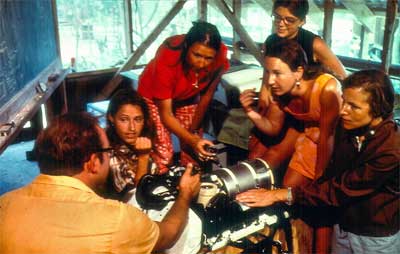
Members of the Tektit II all–women‘s mission,
review the fundamentals of the GE ‘Mark–10’
rebreather unit which greatly extended dive time.
Mission 6–50, the all–women’s mission, received a lot of publicity; they also accrued more in–water research time than their male counterparts. Luckily for humankind, space travel was as viable for women as for men!!
In November 2010, the 40th Anniversary of the end of Tektite II will arrive. If you are on–island, Randy Brown has invited you to join the 53 Aquanauts, the Seabees, and all other 400 Tektiters at VIERS for another celebration. In the meantime, please visit the newly dedicated Tektite Museum to learn more about our St John chapter of Space Exploration History.

